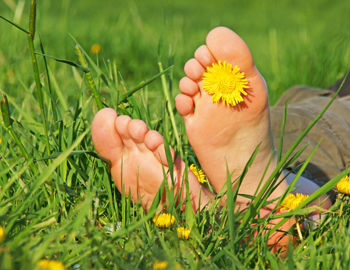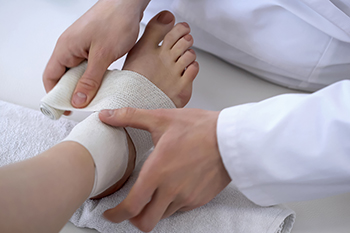Items filtered by date: October 2021
Psoriasis on the Feet
Psoriasis is a skin condition characterized by a red, scaly rash that can appear anywhere on the body, including on the feet. Although there are different types of psoriasis, the most common type is plaque psoriasis. With this type of psoriasis, red, dry patches of skin can form. The scales of the dry skin can get itchy and sore, crack, and even bleed. Another type of psoriasis seen on the feet is palmoplantar pustulosis, which is characterized by tiny, pus-filled blisters on the soles of the feet. Psoriasis is sometimes confused with athlete’s foot, but there are several key differences. While athlete’s foot typically affects the areas between the toes, is itchy, and can make the toenails yellow and brittle, psoriasis typically affects the soles of the feet, causes pain and soreness, can make nails swollen or pitted, and causes joint stiffness. If you have a rash or blisters on your feet, it is suggested that you seek the care of a podiatrist.
Blisters are prone to making everyday activities extremely uncomfortable. If your feet are hurting, contact one of our podiatrists of PA Foot & Ankle Associates. Our doctors can provide the care you need to keep you pain-free and on your feet.
Foot Blisters
Foot blisters develop as a result of constantly wearing tight or ill-fitting footwear. This happens due to the constant rubbing from the shoe, which can often lead to pain.
What Are Foot Blisters?
A foot blister is a small fluid-filled pocket that forms on the upper-most layer of the skin. Blisters are filled with clear fluid and can lead to blood drainage or pus if the area becomes infected.
How Do Blisters Form?
Blisters on the feet are often the result of constant friction of skin and material, usually by shoe rubbing. Walking in sandals, boots, or shoes that don’t fit properly for long periods of time can result in a blister. Having consistent foot moisture and humidity can easily lead to blister formation.
Prevention & Treatment
It is important to properly care for the affected area in order to prevent infection and ease the pain. Do not lance the blister and use a Band-Aid to provide pain relief. Also, be sure to keep your feet dry and wear proper fitting shoes. If you see blood or pus in a blister, seek assistance from a podiatrist.
If you have any questions, please feel free to contact one of our offices located in Allentown, Easton, Northampton, and Chew Street in Allentown, PA . We offer the newest diagnostic and treatment technologies for all your foot care needs.
Wounds That Don't Heal Need to Be Checked
How Does the Cuboid Bone Become Displaced?
Cuboid syndrome, also called cuboid subluxation, occurs when the cuboid bone in the midfoot is displaced. This can happen when the tendons that support the cuboid are injured, usually because of repetitive overuse. The injured or torn tendons pull on the cuboid bone, moving it from its usual position. This produces symptoms such as pain on the outer side of the foot, tenderness, swelling, weakness, and difficulty walking. Cuboid syndrome often occurs following an ankle sprain, and frequently affects dancers, jumpers, sprinters, or anyone who regularly places a great deal of pressure on their feet. For more information about cuboid syndrome, please consult with a podiatrist.
Cuboid syndrome, also known as cuboid subluxation, occurs when the joints and ligaments near the cuboid bone in the foot become torn. If you have cuboid syndrome, consult with one of our podiatrists from PA Foot & Ankle Associates. Our doctors will assess your condition and provide you with quality foot and ankle treatment.
Cuboid syndrome is a common cause of lateral foot pain, which is pain on the outside of the foot. The condition may happen suddenly due to an ankle sprain, or it may develop slowly overtime from repetitive tension through the bone and surrounding structures.
Causes
The most common causes of cuboid syndrome include:
- Injury – The most common cause of this ailment is an ankle sprain.
- Repetitive Strain – Tension placed through the peroneus longus muscle from repetitive activities such as jumping and running may cause excessive traction on the bone causing it to sublux.
- Altered Foot Biomechanics – Most people suffering from cuboid subluxation have flat feet.
Symptoms
A common symptom of cuboid syndrome is pain along the outside of the foot which can be felt in the ankle and toes. This pain may create walking difficulties and may cause those with the condition to walk with a limp.
Diagnosis
Diagnosis of cuboid syndrome is often difficult, and it is often misdiagnosed. X-rays, MRIs and CT scans often fail to properly show the cuboid subluxation. Although there isn’t a specific test used to diagnose cuboid syndrome, your podiatrist will usually check if pain is felt while pressing firmly on the cuboid bone of your foot.
Treatment
Just as the range of causes varies widely, so do treatments. Some more common treatments are ice therapy, rest, exercise, taping, and orthotics.
If you have any questions, please feel free to contact one of our offices located in Allentown, Easton, Northampton, and Chew Street in Allentown, PA . We offer the newest diagnostic and treatment technologies for all your foot care needs.
Arthroscopy for the Ankle
Arthroscopy is a “keyhole” or minimally invasive surgical procedure podiatric surgeons use for viewing and making repairs inside the ankle joint without making large incisions or performing open surgery. An arthroscope (a long, flexible tube with a light and tiny video camera attached) is inserted through a small incision into the ankle joint. The images from the video camera are projected onto a large screen, giving the surgeon a view inside the ankle to assess damage and make a diagnosis. Surgery can be performed with tiny surgical instruments that have been inserted through other small incisions. Arthroscopic surgery reduces the risk of infection, and typically involves shorter hospital stays and reduced recovery times. Make an appointment with a podiatrist to see if arthroscopy might be helpful to diagnose or treat your ankle issue
Foot surgery is sometimes necessary to treat a foot ailment. To learn more, contact one of our podiatrists of PA Foot & Ankle Associates. Our doctors will assist you with all of your foot and ankle needs.
When Is Surgery Necessary?
Foot and ankle surgery is generally reserved for cases in which less invasive, conservative procedures have failed to alleviate the problem. Some of the cases in which surgery may be necessary include:
- Removing foot deformities like bunions and bone spurs
- Severe arthritis that has caused bone issues
- Cosmetic reconstruction
What Types of Surgery Are There?
The type of surgery you receive will depend on the nature of the problem you have. Some of the possible surgeries include:
- Bunionectomy for painful bunions
- Surgical fusion for realignment of bones
- Neuropathy decompression surgery to treat nerve damage
Benefits of Surgery
Although surgery is usually a last resort, it can provide more complete pain relief compared to non-surgical methods and may allow you to finally resume full activity.
Surgical techniques have also become increasingly sophisticated. Techniques like endoscopic surgery allow for smaller incisions and faster recovery times.
If you have any questions please feel free to contact one of our offices located in Allentown, Easton, Northampton, and Chew Street in Allentown, PA . We offer the newest diagnostic and treatment technologies for all your foot and ankle needs.
Ringworm on the Feet
Ringworm is a type of fungal infection that can affect any part of the body. When it affects the feet, it is also known as athlete’s foot. Athlete’s foot can cause some very unpleasant symptoms, including itching, burning, or stinging between the toes, a red, scaly rash on the feet, dry, flaking, or peeling skin, foot blisters, and a foul odor. The infection can also spread to the toenails causing them to become thickened, brittle, and discolored. Fortunately, fungal infections of the feet tend to respond well to treatment. Your podiatrist may prescribe topical antifungal medications, such as creams or powders, that you apply directly to your feet, or oral antifungal medications that you take by mouth. If you have symptoms of ringworm on your feet, please seek the care of a podiatrist.
Athlete’s Foot
Athlete’s foot is often an uncomfortable condition to experience. Thankfully, podiatrists specialize in treating athlete’s foot and offer the best treatment options. If you have any questions about athlete’s foot, consult with one of our podiatrists from PA Foot & Ankle Associates. Our doctors will assess your condition and provide you with quality treatment.
What Is Athlete’s Foot?
Tinea pedis, more commonly known as athlete’s foot, is a non-serious and common fungal infection of the foot. Athlete’s foot is contagious and can be contracted by touching someone who has it or infected surfaces. The most common places contaminated by it are public showers, locker rooms, and swimming pools. Once contracted, it grows on feet that are left inside moist, dark, and warm shoes and socks.
Prevention
The most effective ways to prevent athlete’s foot include:
- Thoroughly washing and drying feet
- Avoid going barefoot in locker rooms and public showers
- Using shower shoes in public showers
- Wearing socks that allow the feet to breathe
- Changing socks and shoes frequently if you sweat a lot
Symptoms
Athlete’s foot initially occurs as a rash between the toes. However, if left undiagnosed, it can spread to the sides and bottom of the feet, toenails, and if touched by hand, the hands themselves. Symptoms include:
- Redness
- Burning
- Itching
- Scaly and peeling skin
Diagnosis and Treatment
Diagnosis is quick and easy. Skin samples will be taken and either viewed under a microscope or sent to a lab for testing. Sometimes, a podiatrist can diagnose it based on simply looking at it. Once confirmed, treatment options include oral and topical antifungal medications.
If you have any questions, please feel free to contact one of our offices located in Allentown, Easton, Northampton, and Chew Street in Allentown, PA . We offer the newest diagnostic and treatment technologies for all your foot care needs.






